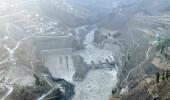'You don't know what you are going to encounter every 10-20 metres.'
'These mountains are unpredictable.'

"We think rocks are very strong objects, but they are not. A single piece of rock can be strong, but a mountain is not made up of a single piece of rock. It is made up of a mass of rock split into many, many, pieces.
"There are plenty of reasons for the disintegration of rocks -- tectonics, weathering etc, and you need some support system that can support the fractured rock from below [during tunnelling].
"If the support system is not good enough for the rock mass, it will collapse," says Dr Naresh Rana, Assistant Professor, Department of Geology, Delhi University.
Dr Rana's research interests include natural hazards, active tectonics and paleoclimate. He has more than 30 publications in international journals.
In a phone conversation with Rediff.com's Archana Masih, Dr Rana explains the complexities of the Himalayas and the challenge of the terrain in carrying out the Herculean rescue of the 41 workers trapped inside the tunnel.
Could you give us a sense of the region and terrain where this tunnel is being constructed?
The area is part of the Lesser Himalayas region comprising phyllite rocks which are metamorphic rocks and are not very strong.
The most challenging part of the Himalayas is that it is a folded and faulted mountain range. It is not a very stable and strong mountain. You don't know what you are going to encounter every 10 to 20 metres.
There is a complexity about it. There are many weak planes. The Himalayas are being pushed towards the north. Therefore, there is a compression which is continuously breaking down the rocks and creating new fractures.
The process is still alive and one cannot predict what is going to happen in a given area or division of the Himalayas.
The Himalayas will always surprise you and you will always encounter the unexpected.

How is the Himalayan terrain and physical features of the region contributing to the difficulties in the tunnel rescue?
The under construction tunnel is about 4.5 kilometres. It is being excavated from both ends while around 500 metres of the excavation still remains to be done.
It appears that the accident happened when the workers were replacing the temporary support system of the tunnel with a permanent lining.
Tunnel excavation is a sophisticated exercise and requires extensive treatment after the excavation process.
Constructing a tunnel is a complex process as compared to constructing a road. Underground tunnelling in the Himalayas or anywhere requires extra precautions because all the activity is underground and the field of vision is restricted as compared to over ground construction.
One encounters tremendous stress known as lithostatic pressure as one goes deeper into the ground due to the weight of the rocks and overlying materials above the tunnel.
This pressure is disturbed during excavation and needs to be supported to provide stability.

What are some of the most important precautions that need to be followed while carrying out excavation for tunnelling in the Himalayas?
During excavation there is disturbance in the underground system which becomes unstable at that location and needs to be provided with some extra support.
We think rocks are very strong objects, but they are not. A single piece of rock can be strong, but a mountain is not made up of a single piece of rock. It is made up of a mass of rock split into many, many pieces.
There are plenty of reasons for the disintegration of rocks - tectonics, weathering etc and you certainly need some support system that can support the fractured rock from below.
If the support system is not good enough for the rock mass, it will collapse.

And this probably has led to the collapse of around 50 metres of the tunnel?
Unstable rocks and material fall down -- for example, if you remove two trucks of material, two trucks worth will fall down again.
That's why prior to the excavation, geologists go to the location and characterise the rock mass, and what kind of support system is required to support this rock.
If the characterisation is not done correctly and the appropriate support system is not set up it can lead to an accident.
Around 50 metres of the tunnel has collapsed, and if you remove the debris, there is a likelihood more material will again fall.
This accident appears to be a planning and execution failure which can happen due to many reasons, but particularly because of the ignorance of the complexity of Himalaya terrain.
The precautionary and safety measures did not meet the required parameters. What happened is a matter of investigation and nobody knows the exact cause as yet.
The immediate challenge is to remove the material and rescue the workers.

It has been a herculean task to push the pipe through the debris to get food to the workers and work has been going to insert a wider pipe so that the workers can be extracted.
What are the difficulties of drilling in such circumstances?
Strong drilling equipment is required to penetrate through the high pressure debris that extends for about 50 to 60 metres with a lot of overburden.
It requires sophisticated heavy machinery that has to be moved into the mountains which is not an easy task. The instruments and heavy machinery needed for the rescue had to be transported from elsewhere because they did not expect that such an accident could occur.
Those involved in the rescue must be assessing the situation and dealing with the situation appropriately.
- Part 2 of the Interview: 'We repeat the same mistakes'
Feature Presentation: Aslam Hunani/Rediff.com










